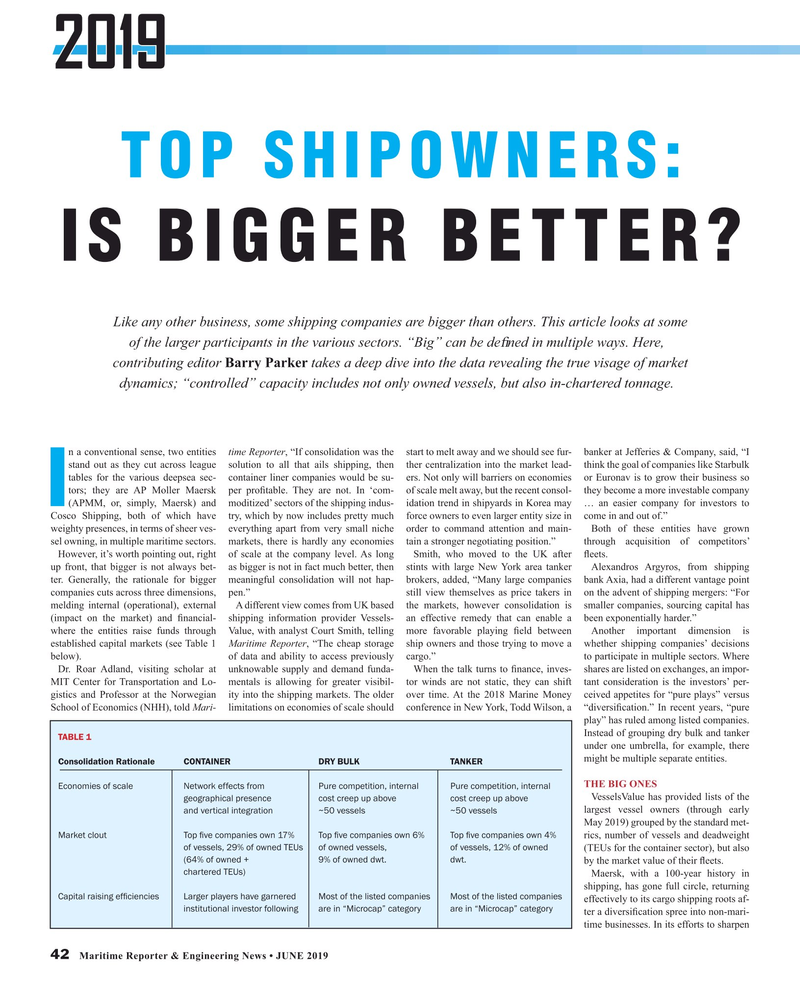
Page 42: of Maritime Reporter Magazine (June 2019)
80th Anniversary World Yearbook
Read this page in Pdf, Flash or Html5 edition of June 2019 Maritime Reporter Magazine
2019
TOP SHIPOWNERS:
IS BIGGER BETTER?
Like any other business, some shipping companies are bigger than others. This article looks at some of the larger participants in the various sectors. “Big” can be de? ned in multiple ways. Here, contributing editor Barry Parker takes a deep dive into the data revealing the true visage of market dynamics; “controlled” capacity includes not only owned vessels, but also in-chartered tonnage. n a conventional sense, two entities time Reporter, “If consolidation was the start to melt away and we should see fur- banker at Jefferies & Company, said, “I stand out as they cut across league solution to all that ails shipping, then ther centralization into the market lead- think the goal of companies like Starbulk tables for the various deepsea sec- container liner companies would be su- ers. Not only will barriers on economies or Euronav is to grow their business so tors; they are AP Moller Maersk per pro? table. They are not. In ‘com- of scale melt away, but the recent consol- they become a more investable company
I(APMM, or, simply, Maersk) and moditized’ sectors of the shipping indus- idation trend in shipyards in Korea may … an easier company for investors to
Cosco Shipping, both of which have try, which by now includes pretty much force owners to even larger entity size in come in and out of.” weighty presences, in terms of sheer ves- everything apart from very small niche order to command attention and main- Both of these entities have grown sel owning, in multiple maritime sectors. markets, there is hardly any economies tain a stronger negotiating position.” through acquisition of competitors’
However, it’s worth pointing out, right of scale at the company level. As long Smith, who moved to the UK after ? eets.
up front, that bigger is not always bet- as bigger is not in fact much better, then stints with large New York area tanker Alexandros Argyros, from shipping ter. Generally, the rationale for bigger meaningful consolidation will not hap- brokers, added, “Many large companies bank Axia, had a different vantage point companies cuts across three dimensions, pen.” still view themselves as price takers in on the advent of shipping mergers: “For melding internal (operational), external A different view comes from UK based the markets, however consolidation is smaller companies, sourcing capital has (impact on the market) and ? nancial- shipping information provider Vessels- an effective remedy that can enable a been exponentially harder.” where the entities raise funds through Value, with analyst Court Smith, telling more favorable playing ? eld between Another important dimension is established capital markets (see Table 1 Maritime Reporter, “The cheap storage ship owners and those trying to move a whether shipping companies’ decisions below). of data and ability to access previously cargo.” to participate in multiple sectors. Where
Dr. Roar Adland, visiting scholar at unknowable supply and demand funda- When the talk turns to ? nance, inves- shares are listed on exchanges, an impor-
MIT Center for Transportation and Lo- mentals is allowing for greater visibil- tor winds are not static, they can shift tant consideration is the investors’ per- gistics and Professor at the Norwegian ity into the shipping markets. The older over time. At the 2018 Marine Money ceived appetites for “pure plays” versus
School of Economics (NHH), told Mari- limitations on economies of scale should conference in New York, Todd Wilson, a “diversi? cation.” In recent years, “pure play” has ruled among listed companies.
Instead of grouping dry bulk and tanker
TABLE 1 under one umbrella, for example, there might be multiple separate entities.
Consolidation Rationale CONTAINER DRY BULK TANKER
THE BIG ONES
Economies of scale Network effects from Pure competition, internal Pure competition, internal
VesselsValue has provided lists of the geographical presence cost creep up above cost creep up above largest vessel owners (through early and vertical integration ~50 vessels ~50 vessels
May 2019) grouped by the standard met-
Market clout Top ? ve companies own 17% Top ? ve companies own 6% Top ? ve companies own 4% rics, number of vessels and deadweight of vessels, 29% of owned TEUs of owned vessels, of vessels, 12% of owned (TEUs for the container sector), but also (64% of owned + 9% of owned dwt. dwt.
by the market value of their ? eets. chartered TEUs)
Maersk, with a 100-year history in shipping, has gone full circle, returning
Capital raising ef? ciencies Larger players have garnered Most of the listed companies Most of the listed companies effectively to its cargo shipping roots af- institutional investor following are in “Microcap” category are in “Microcap” category ter a diversi? cation spree into non-mari- time businesses. In its efforts to sharpen 42 Maritime Reporter & Engineering News • JUNE 2019
MR #6 (42-49).indd 42 6/3/2019 3:30:03 PM

 41
41

 43
43
